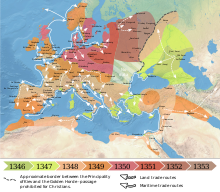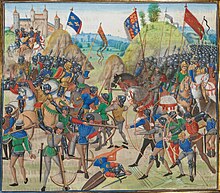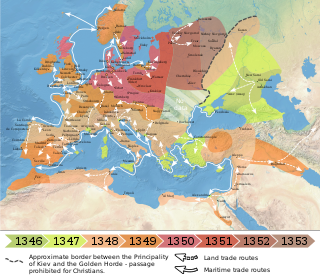
The Black Death was a bubonic plague pandemic occurring in Europe from 1346 to 1353. One of the most fatal pandemics in human history, as many as 50 million people perished, perhaps 50% of Europe's 14th century population. Bubonic plague is caused by the bacterium Yersinia pestis and spread by fleas. One of the most significant events in European history, the Black Death had far-reaching population, economic, and cultural impacts. It was the beginning of the second plague pandemic. The plague created religious, social and economic upheavals, with profound effects on the course of European history.
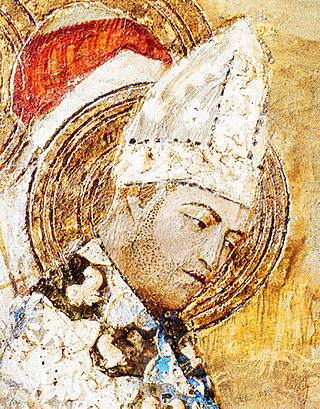
Pope Clement VI, born Pierre Roger, was head of the Catholic Church from 7 May 1342 to his death, in December 1352. He was the fourth Avignon pope. Clement reigned during the first visitation of the Black Death (1348–1350), during which he granted remission of sins to all who died of the plague.

The 14th century lasted from 1 January 1301 to 31 December 1400 (MCD). It is estimated that the century witnessed the death of more than 45 million lives from political and natural disasters in both Europe and the Mongol Empire. West Africa experienced economic growth and prosperity.
The 1340s was a decade that began on 1 January 1340 and ended on 31 December 1349. It was in the midst of a period in human history often referred to as the Late Middle Ages in the Old World and the pre-Columbian era in the New World.
Year 1349 (MCCCXLIX) was a common year starting on Thursday of the Julian calendar.
Year 1347 (MCCCXLVII) was a common year starting on Monday of the Julian calendar, and a common year starting on Sunday of the Proleptic Gregorian calendar.

Amadeus VI, nicknamed the Green Count was Count of Savoy from 1343 to 1383. He was the eldest son of Aymon, Count of Savoy, and Yolande Palaeologina of Montferrat. Though he started under a regency, he showed himself to be a forceful leader, continuing Savoy's emergence as a power in Europe politically and militarily. He participated in a crusade against the Turks who were moving into Europe.
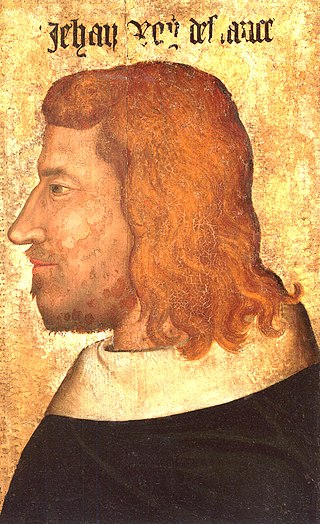
John II, called John the Good, was King of France from 1350 until his death in 1364. When he came to power, France faced several disasters: the Black Death, which killed nearly one-third to one-half of its population; popular revolts known as Jacqueries; free companies of routiers who plundered the country; and English aggression that resulted in catastrophic military losses, including the Battle of Poitiers of 1356, in which John was captured.

Louis V, called the Brandenburger, a member of the House of Wittelsbach, ruled as Margrave of Brandenburg from 1323 to 1351 and as Duke of Bavaria from 1347 until his death. From 1342 he also was co-ruling Count of Tyrol by his marriage with the Meinhardiner countess Margaret.
Events from the 1340s in England

William Bateman was a medieval Bishop of Norwich.

The Black Death was one of the most devastating pandemics in human history, resulting in the deaths of an estimated 75 to 200 million people in Eurasia, and peaking in Eurasia from 1321 to 1353. Its migration followed the sea and land trading routes of the medieval world. This migration has been studied for centuries as an example of how the spread of contagious diseases is impacted by human society and economics.

The Black Death was a bubonic plague pandemic, which reached England in June 1348. It was the first and most severe manifestation of the second pandemic, caused by Yersinia pestis bacteria. The term Black Death was not used until the late 17th century.

The second plague pandemic was a major series of epidemics of plague that started with the Black Death, which reached medieval Europe in 1346 and killed up to half of the population of Eurasia in the next four years. It followed the first plague pandemic that began in the 6th century with the Plague of Justinian, but had ended in the 8th century. Although the plague died out in most places, it became endemic and recurred regularly. A series of major epidemics occurred in the late 17th century, and the disease recurred in some places until the late 18th century or the early 19th century. After this, a new strain of the bacterium gave rise to the third plague pandemic, which started in Asia around the mid-19th century.

The persecution of Jews during the Black Death consisted of a series of violent mass attacks and massacres. Jewish communities were often blamed for outbreaks of the Black Death in Europe. From 1348-1351, acts of violence were committed in Toulon, Barcelona, Erfurt, Basel, Frankfurt, Strasbourg and elsewhere. The persecutions led to a large migration of Jews to Jagiellonian Poland and the Grand Duchy of Lithuania. There are very few Jewish sources on Jewish massacres during the Plague.
Lodewijk Heyligen was a Flemish Benedictine monk and music theorist who served as the master of music of cardinal Giovanni Colonna in Avignon. There he became one of the closest friends of the Italian poet Petrarch. His Latin name Ludovicus Sanctus means Louis the Saint and is a literal translation of the Flemish name Lodewijk Heyligen.
The Truce of Calais was a truce agreed by King Edward III of England and King Philip VI of France on 28 September 1347, which was mediated by emissaries of Pope Clement VI. The Hundred Years' War had broken out in 1337 and in 1346 Edward had landed with an army in northern France. After inflicting a heavy defeat on Philip and a French army at the Battle of Crécy the English besieged Calais, which fell after 11 months. Both countries were financially and militarily exhausted and two cardinals acting for Pope Clement were able to broker a truce in a series of negotiations outside Calais. This was signed on 28 September to run until 7 July 1348.

The Black Death was present in the Holy Roman Empire between 1348 and 1351. The Holy Roman Empire, composed of today's Germany, Switzerland, Austria, Belgium and the Netherlands, was, geographically, the largest country in Europe at the time, and the pandemic lasted several years due to the size of the Empire.

The Black Death was present in Denmark between 1348 and 1350. The Black Death in Denmark is the least of from all the Nordic countries with the exception of Finland.

The Black Death was present in the Middle East between 1347 and 1349. The Black Death in the Middle East is described more closely in the Mamluk Sultanate, and to a lesser degree in Marinid Sultanate of Morocco, the Sultanate of Tunis, and the Emirate of Granada, while information of it in Iran and the Arabian Peninsula is lacking. The Black Death in Cairo, at the time the biggest city in the Mediterranean region, was one of the biggest documented demographic catastrophes during the Black Death.
